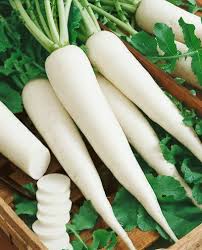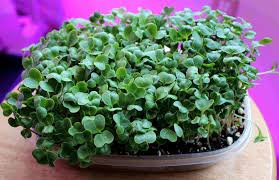Radishes are not exactly the most popular vegetables around, but they are one of the healthiest. Radishes are often used in the culinary world and add a pungent, peppery element to dishes. The vegetables also contains an array of vitamins, minerals and nutritional compounds that can positively affect your health. There are many different types of radishes: black radish, daikon radish, horseradish, watermelon radish, and round radish.
Radishes can be prepared in many different ways, they can be pickled, used in sandwiches, roasted as part of a vegetable medley or added to casseroles for a pungent crunch. One of the most popular ways to eat radishes is to slice them and eat them in a salad.
Have you ever been conned to eat something you despise, and then actually grown to like it? My list is, or rather used to be, fairly long. And somewhere right on top was radish, or rather the humble mooli. It would take serious coercion to get me to eat it irrelevant of the various ways it was camouflaged – in a curry, parathas, dal, or even a salad.

Incidentally, there are various kids of radishes with some growing in spring and summer, and some in winter. Daikon, the white variety most commonly found in India, is a spring-summer vegetable. The other varieties available in the country are the pink, and sometimes even the black. Now even though not everyone likes radish, it comes with a host of health benefits.
For instance, radish actually helps to cleanse our liver and stomach, thus detoxifying it; black radish and its leaves have been used for the longest time to treat jaundice because it can get rid of excess bilirubin. And because of that particular property, it also helps to purify our blood. They keep hypothyroidism in check too, thanks to its sulphur content.
Nutritional Value Of Radish
The reason why radishes taste so pungent and spicy is because they are high in nutrients. Radishes have excellent nutritional value compared to other vegetables like bitter gourd and leafy greens which are packed with nutrients. Radishes are also used to treat illnesses such as sore throat, bile disorders and inflammation in Ayurveda and Traditional Chinese Medicine.
Here is the nutritional profile of 1 cup of raw, sliced radishes (116 grams)
- Calories – 19
- Protein – 0.8 g
- Carbohydrates – 4 g
- Fiber – 1.9 g
- Fat – 0.1g
Vitamins and Minerals

Radishes have an abundance of vitamins and minerals. These vitamins and minerals include:
Folate: Also known as a B vitamin, it synthesizes white/red blood cells in bone marrow and is essential for the process of creating DNA and RNA.
Potassium: This mineral regulates and keeps fluids of the body in balance. It also supports electrical activity of the heart and the function of the entire nervous system.
Vitamin C: Vitamin C is involved with many important functions in the body and can help with the formation of collagen and the strengthening of blood vessel walls.
Vitamin B6: A water soluble vitamin, also known as pyridoxine, is needed for numerous enzyme reactions in the body, mainly metabolism.
Health Benefits of Radish
The nutritional profile of radishes is very diverse and offers a wide scope of nutrients that can have a profound effect on health. From folate to sulfur compounds, radishes target many different aspects of the body and can contribute positively to a healthy system, inside and out.
Here are some of the top ways radishes can benefit your health:
1. Prevents Cancer
Radish contains glucosinolates, which are sulfur-containing compounds found in cruciferous vegetables. These compounds protect your cells from the genetic mutations that can cause cancer. They may also help eliminate cells that have the potential to grow into cancerous cells in the future.
2. Supports Digestion
Eating enough fibre each day (25 g for a woman, and 30-38 g for a man) can prevent constipation, acid reflux and digestive disorders such as irritable bowel syndrome. Radishes contain a good amount of fibre at 1.9 g per 116 g of vegetables. Consuming a serving of radishes each day will provide the fibre you need to ensure a fully functioning digestive system.
A study showed that consuming the leaves of radishes made a positive impact on digestion. Radishes may also help gastric ulcers by reinforcing the stomach lining and protecting other tissues in the gut.
3. Helps to Fight Fungus
Candida albicans is one of the most common fungi found in the human body. It’s also one of the hardest to fight off. An overgrowth of Candida albicans can cause vaginal infections and oral infections. Radish contains an antifungal compound, RsAFP2 that has been proven effective against strains of Candida bacteria.
4. Prevents Diabetes
If you have prediabetes or have blood sugar issues, consuming radish can help regulate blood sugar and prevent the on-set of diabetes type 2.
This vegetable contains anti-diabetic properties that can enhance immune system function, improve glucose uptake and lower blood sugar. A study showed that radishes directly improve insulin response and glucose metabolism.
Adiponectin is a hormone that is involved in the reduction of glucose levels in the blood. Radishes contain compounds that regulate adiponectin and other hormones that play a role in regulating glucose homeostasis.
5. Improves Skin

Not only is radish extremely hydrating, but the vegetable also contains high levels of vitamin C, a vitamin known to be very beneficial for the skin. Vitamin C improves elasticity of the skin by helping to form collagen, a nutrient that makes up the structure of the skin, bones and other connective tissue. In addition to that, it fights against free radicals and provides a boost of UV protection for the skin. The folate in radishes reduces oxidative damage and the vitamin B6 can reduce stress that prevent breakouts and premature aging.
If you drink radish juice every day, you’re giving your skin special boosters to stay healthy, and that’s mostly because of the Vitamin C, zinc, and phosphorus. Plus it also keeps dryness, acne, pimples, and rashes at bay. Plus you can use radish paste to cleanse your face. And if you apply it on your hair, it helps to remove dandruff, prevent hair loss, and strengthens the root too.
6. Very Hydrating
Staying hydrated is important to keep your body functioning optimally. A lack of hydration can cause poor skin appearance, headaches, frequent illness, and sugar cravings. Radishes have a very high water content, 93.5 g per every 100 g! That’s almost on par with a cucumber which is 95.2 g per 100 g. Incorporating radishes into your everyday meals along with drinking the recommended amount of water per day will ensure you’re getting the hydration you need.
7. Supports Heart Health
Anthocyanins are a type of flavonoid with antioxidant effects that can be particularly helpful in supporting heart health. Anthocyanins are present in radishes, which give round radishes their red color. Foods high in anthocyanins, like radishes have been linked to a lower risk of cardiovascular disease. These foods also have an effect on cholesterol levels, triglyceride levels and blood pressure.
8. Lowers Blood Pressure
Potassium has regulating properties that can balance out fluids in the body. Potassium has a very positive effect on blood pressure and can effectively bring the blood pressure down to a normal level through the function of the kidneys. Radishes contain moderately high levels of potassium and can help in balancing blood pressure for those with hypertension. In addition to this, radishes, through the synthesis of collagen can strengthen the blood vessel walls and lower the risk of atherosclerosis.
1. Saves those RBCs: Radish is known to control damage to our red blood cells, and in the process also increases oxygen supply to the blood.
2. High on Fiber: If you eat it as part of your daily salad intake salad intake, without going overboard of course, radish also provides your system with ample roughage and fibers, therefore improving your digestion. It also regulates bile production, safeguards your liver and the gall bladder, and is great for taking care of water retention.
3. Guards the Heart: Radishes are a good source for anthocyanins that keep our hearts functioning properly, reducing the risk of cardiovascular diseases. Plus they are high on vitamin C, folic acid, and flavonoids too.
4. Controls Blood Pressure: Radish also provides your body with potassium, which can help lower your blood pressure, and keep your blood flow in control, especially if you are known to suffer from hypertension. According to Ayurveda, radish is believed to have a cooling effect on the blood.
5. Improves Immunity: Given that the radish has high vitamin C, it can protect you from common cold and cough, and improve your basic immunity system. But you must consume it regularly. It also controls the development of harmful free radicals, inflammation and early ageing.
6. Fortifies Blood Vessels: Now this is important – radish plays an important role in the generation of collagen, which in turn boosts our blood vessels and decreases our chances of getting atherosclerosis.
7. Metabolism-Friendly: This root vegetable is not only good for your digestive system, but it also helps to fix acidity, obesity, gastric problems, and nausea, among others.
8. High on Nutrients: Red radishes are packed with Vitamins E, A, C, B6, and K. Plus it’s high on antioxidants, fiber, zinc, potassium, phosphorous, magnesium, copper, calcium, iron and manganese. And each of these is known to keep our body in good working condition.
9. Good for the Skin: If you drink radish juice every day, you’re giving your skin special boosters to stay healthy, and that’s mostly because of the Vitamin C, zinc, and phosphorus. Plus it also keeps dryness, acne, pimples, and rashes at bay. Plus you can use radish paste to cleanse your face. And if you apply it on your hair, it helps to remove dandruff, prevent hair loss, and strengthens the root too.
10. Good for Hydration: If you tend to eat radish a little more in summer, it’s probably because it keeps the body hydrated because of its high water content.
Cooking with Radish

Now if you thought there is only so much you could do with radish, you’d be wrong. Apart from slicing it really thin, almost like Carpaccio if you can, and serving it with salad, there are plenty of other ways to maximise this vegetable. From making chutneys (such as the famous mullangi pachadi, a famous Andhra chutney) and curries or a poriyal, to using it to stuff parathas, or even adding it to raita – the options are aplenty.
For instance, you can make slices of radish, mash avocado, and use generous smears of goat cheese and use it to fill delicious multigrain bread slices for a quick sandwich – the bite of the radish, and the subtle flavours from the avocado can be a good pairing. Plus there’s always cheese to add to the taste. You can also make a delicious radish soup, in case you need something comforting. It requires a bit of work, but the end result is quite tasty. And this is just the beginning. For interesting radish recipes
Mullangi (white radish) rasam
Preparation

- When oil is heated, saute the shallots, onions and tomatoes to soften (3-4mins)
Add in all the spices as well as the chillies.
Keep stirring over low heat until a thick paste forms.
Add 1/2 liter of water, then the radish and salt to taste.
Stir all together and continue to simmer until very small bubbles appear.
Off the heat and add the coriander leaves and spring onion.
Just a good stir before being served.
